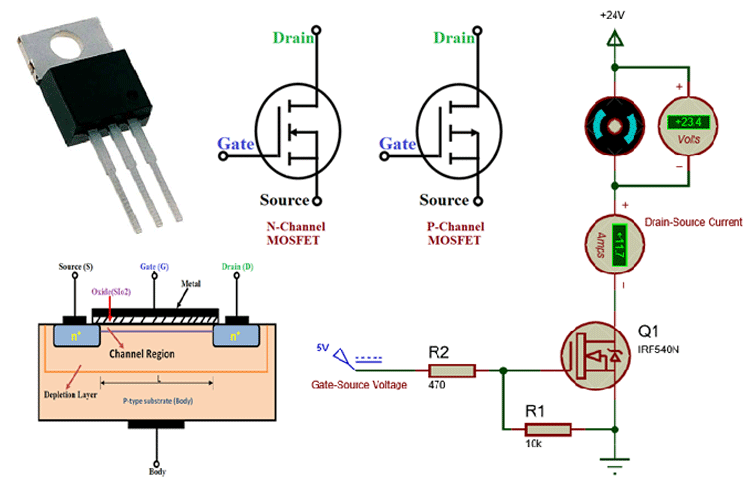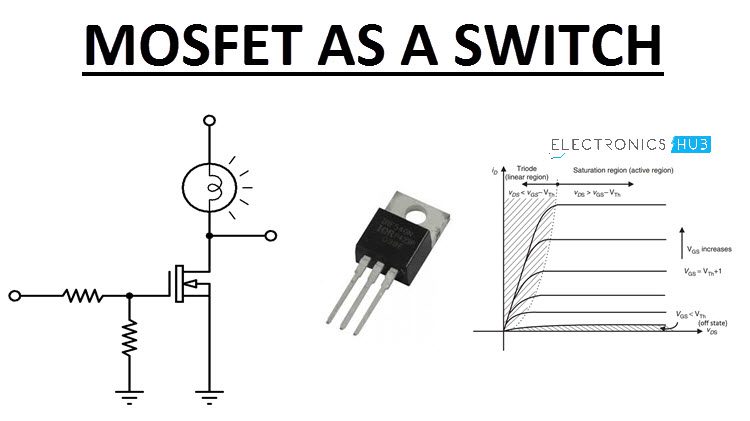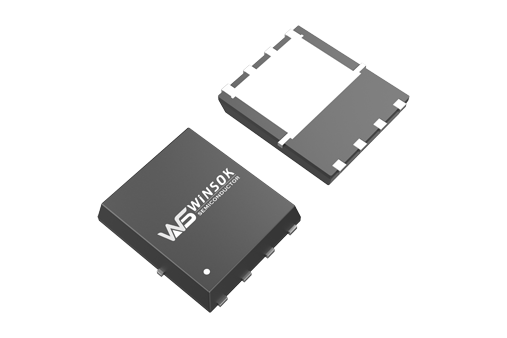Understanding MOSFET Basics
What is a MOSFET?
A MOSFET is a voltage-controlled semiconductor device that regulates the flow of electrical current. It’s essentially a switch that can be turned on or off by applying a voltage to its gate terminal. Unlike traditional bipolar transistors, MOSFETs are controlled by voltage rather than current, making them more energy-efficient and easier to use in many applications.
Basic Structure and Terminals

A MOSFET consists of three main terminals:
- Gate (G): The control terminal that determines whether the MOSFET conducts or not
- Drain (D): The terminal where current flows out
- Source (S): The terminal where current flows in
Types of MOSFETs
| Type | Channel | Main Applications | Key Characteristics |
|---|---|---|---|
| N-Channel | Electron conduction | Power switching, amplification | Higher efficiency, faster switching |
| P-Channel | Hole conduction | High-side switching | Simpler circuit design in some cases |
Common MOSFET Application Circuits
1. Basic Switching Circuit
The most fundamental application of a MOSFET is as a switch. Here’s how to implement a basic switching circuit:
Key Components Needed:
- N-channel MOSFET (We recommend Winsok’s WS2302 series)
- Gate resistor (typically 10kΩ)
- Load (LED, motor, etc.)
- Power supply
Featured Product: Winsok WS2302 N-Channel MOSFET
- Low RDS(on) of 0.027Ω
- Fast switching speed
- Excellent thermal performance
- Perfect for switching applications
2. Motor Control Circuit
 MOSFETs are excellent for controlling DC motors due to their low power loss and fast switching capabilities. Here’s a typical setup:
MOSFETs are excellent for controlling DC motors due to their low power loss and fast switching capabilities. Here’s a typical setup:
Circuit Configuration:
- Use a logic-level MOSFET for direct microcontroller control
- Add a flyback diode across the motor
- Include a gate resistor to limit current spikes
- Consider using a MOSFET driver for larger motors
Pro Tip: When driving motors, always use a freewheeling diode to protect the MOSFET from back EMF. Winsok’s WS9320 series MOSFETs come with built-in protection features, making them ideal for motor control applications.
3. LED Driver Circuit
MOSFETs are commonly used in LED driving applications, especially for high-power LEDs. Here’s a practical implementation:
| Parameter | Recommended Value | Notes |
|---|---|---|
| Gate Voltage | 10-12V | For full enhancement |
| Gate Resistor | 100Ω – 1kΩ | Limits gate current |
| PWM Frequency | 1kHz – 20kHz | For brightness control |
4. High-Side Switching
While N-channel MOSFETs are more common for low-side switching, sometimes high-side switching is necessary. Here’s how to implement it:
High-Side Switching Considerations:
- Use a P-channel MOSFET for simpler drive requirements
- Consider a charge pump or bootstrap circuit for N-channel MOSFETs
- Account for body diode effects
- Calculate power dissipation carefully
Recommended for High-Side Switching: Winsok WP5439 P-Channel MOSFET
- -30V VDS rating
- -9.4A continuous current
- Ultra-low RDS(on)
- Perfect for high-side applications
How to Use a MOSFET as a Voltage Controller
MOSFETs can effectively control voltage in various applications. Here’s a detailed look at voltage control implementations:
Linear Voltage Regulation
While MOSFETs are commonly used as switches, they can also operate in their linear region for voltage control. However, this requires careful consideration of power dissipation.
Key Implementation Steps:
- Operate the MOSFET in its saturation region
- Use feedback for precise voltage control
- Consider thermal management
- Implement proper biasing
Recommended: Winsok WS4532 Series
Ideal for linear voltage control applications with:
- Extended safe operating area
- Excellent thermal characteristics
- Linear behavior in saturation region
Voltage Level Translation
MOSFETs can be used to convert voltage levels between different circuits. Common applications include:
- 3.3V to 5V logic level conversion
- Interfacing microcontrollers with higher voltage peripherals
- Bidirectional voltage translation
Detailed Guide: Using a MOSFET as a Switch
Basic Switching Configurations
| Configuration | Advantages | Considerations |
|---|---|---|
| Low-Side Switch | Simple to implement, easy gate drive | Load connected to power supply |
| High-Side Switch | Better safety, ground-referenced load | Requires gate drive above supply |
| H-Bridge | Bidirectional control, full voltage swing | Complex gate driving, shoot-through protection needed |
Gate Drive Requirements
For Optimal Switching Performance:
- Gate voltage should exceed threshold by several volts
- Typical gates voltages:
- Logic-level MOSFETs: 3.3V – 5V
- Standard MOSFETs: 10V – 12V
- High-voltage MOSFETs: 15V – 20V
- Include gate resistance to control switching speed
Advanced MOSFET Applications
Synchronous Rectification
Using MOSFETs as synchronous rectifiers can significantly improve power supply efficiency:
- Replace diodes in rectifier circuits
- Reduce voltage drop and power loss
- Improve overall system efficiency
- Common in DC-DC converters and power supplies
Winsok WSR8503 – Optimized for Synchronous Rectification
- Ultra-low RDS(on) for minimum power loss
- Fast recovery body diode
- Excellent switching characteristics
Power Factor Correction (PFC)
MOSFETs play a crucial role in active PFC circuits:
- High-frequency switching operation
- Boost converter topology
- Improved power quality
- Enhanced system efficiency
Design Tip: When using MOSFETs in PFC applications, consider using Winsok’s high-voltage series with optimized switching characteristics for reduced EMI and improved efficiency.
Design and Selection Guidelines
Key Parameters for MOSFET Selection
| Parameter | Description | Typical Requirements |
|---|---|---|
| VDS(max) | Maximum drain-source voltage | ≥ 1.5× circuit voltage |
| ID(max) | Maximum drain current | ≥ 2× load current |
| RDS(on) | On-state resistance | Application dependent |
| Gate charge | Total gate charge | Lower for high-frequency |
Need Help With MOSFET Selection?
Olukey offers comprehensive support for your MOSFET requirements:
- Free technical consultation
- Parameter optimization assistance
- Application-specific recommendations
- Sample evaluation support
Expert Support Available: Our engineering team at Olukey can help you optimize your MOSFET implementation for maximum performance and reliability. Contact us today to discuss your specific requirements and learn how Winsok’s extensive MOSFET portfolio can benefit your design.
Best Practices and Troubleshooting
Design Considerations
- Always include gate resistors to prevent oscillations
- Consider heat dissipation in your PCB design
- Use appropriate gate drive voltage for full enhancement
- Add protection circuits for sensitive applications
Need Expert Advice? Our technical team at Olukey can help you select the right MOSFET for your application. With our extensive experience and Winsok’s comprehensive product line, we ensure you get the optimal solution for your design.
Common Issues and Solutions
| Issue | Possible Cause | Solution |
|---|---|---|
| MOSFET gets hot | Operating in linear region | Ensure proper gate voltage for full enhancement |
| Switching noise | Fast switching transients | Add gate resistance, improve layout |
| Failure to turn on | Insufficient gate voltage | Check gate drive circuit, use logic-level MOSFET |
Why Choose Olukey and Winsok MOSFETs?
- Authorized distributor with genuine Winsok products
- Technical support from experienced engineers
- Competitive pricing and reliable supply chain
- Wide selection of MOSFETs for various applications
- Quick sample delivery and volume production support
Ready to Start Your Project?
Contact our technical sales team for:
- Product recommendations
- Sample requests
- Technical support
- Volume pricing


























